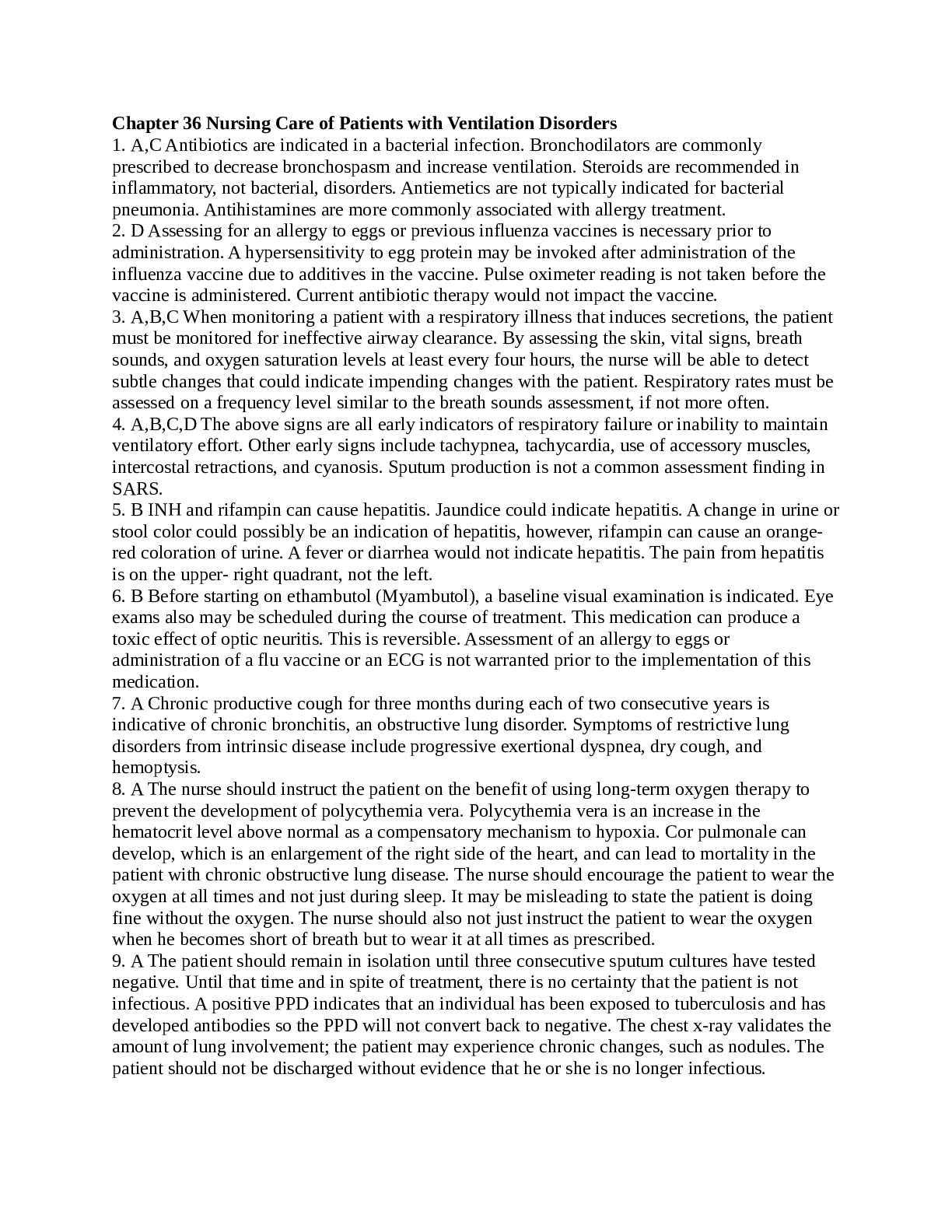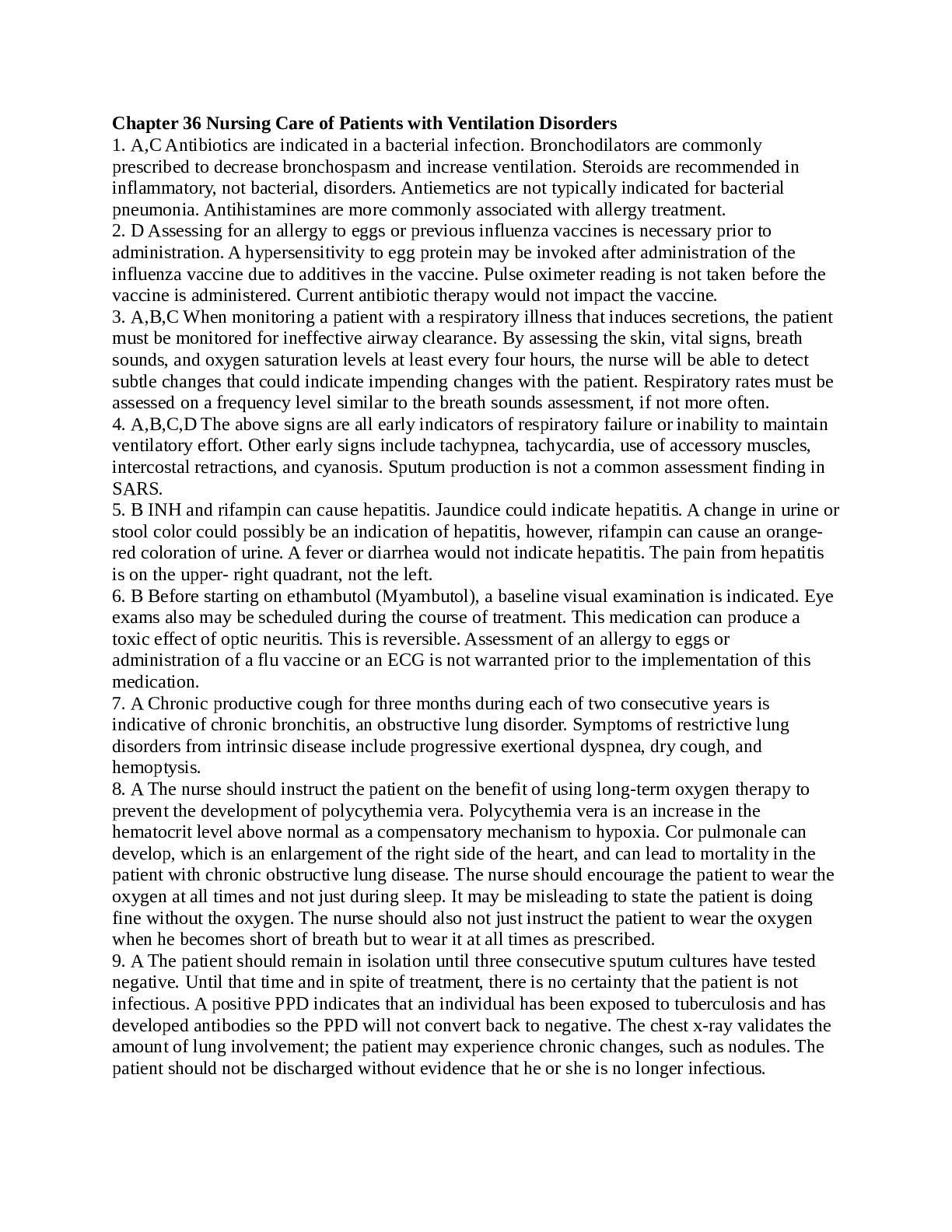Chapter 36 Nursing Care of Patients with Ventilation Disorders
1. A,C Antibiotics are indicated in a bacterial infection. Bronchodilators are commonly
prescribed to decrease bronchospasm and increase ventilation. Steroids are recommended in
inflammatory, not bacterial, disorders. Antiemetics are not typically indicated for bacterial
pneumonia. Antihistamines are more commonly associated with allergy treatment.
2. D Assessing for an allergy to eggs or previous influenza vaccines is necessary prior to
administration. A hypersensitivity to egg protein may be invoked after administration of the
influenza vaccine due to additives in the vaccine. Pulse oximeter reading is not taken before the
vaccine is administered. Current antibiotic therapy would not impact the vaccine.
3. A,B,C When monitoring a patient with a respiratory illness that induces secretions, the patient
must be monitored for ineffective airway clearance. By assessing the skin, vital signs, breath
sounds, and oxygen saturation levels at least every four hours, the nurse will be able to detect
subtle changes that could indicate impending changes with the patient. Respiratory rates must be
assessed on a frequency level similar to the breath sounds assessment, if not more often.
4. A,B,C,D The above signs are all early indicators of respiratory failure or inability to maintain
ventilatory effort. Other early signs include tachypnea, tachycardia, use of accessory muscles,
intercostal retractions, and cyanosis. Sputum production is not a common assessment finding in
SARS.
5. B INH and rifampin can cause hepatitis. Jaundice could indicate hepatitis. A change in urine or
stool color could possibly be an indication of hepatitis, however, rifampin can cause an orange-
red coloration of urine. A fever or diarrhea would not indicate hepatitis. The pain from hepatitis
is on the upper- right quadrant, not the left.
6. B Before starting on ethambutol (Myambutol), a baseline visual examination is indicated. Eye
exams also may be scheduled during the course of treatment. This medication can produce a
toxic effect of optic neuritis. This is reversible. Assessment of an allergy to eggs or
administration of a flu vaccine or an ECG is not warranted prior to the implementation of this
medication.
7. A Chronic productive cough for three months during each of two consecutive years is
indicative of chronic bronchitis, an obstructive lung disorder. Symptoms of restrictive lung
disorders from intrinsic disease include progressive exertional dyspnea, dry cough, and
hemoptysis.
8. A The nurse should instruct the patient on the benefit of using long-term oxygen therapy to
prevent the development of polycythemia vera. Polycythemia vera is an increase in the
hematocrit level above normal as a compensatory mechanism to hypoxia. Cor pulmonale can
develop, which is an enlargement of the right side of the heart, and can lead to mortality in the
patient with chronic obstructive lung disease. The nurse should encourage the patient to wear the
oxygen at all times and not just during sleep. It may be misleading to state the patient is doing
fine without the oxygen. The nurse should also not just instruct the patient to wear the oxygen
when he becomes short of breath but to wear it at all times as prescribed.
9. A The patient should remain in isolation until three consecutive sputum cultures have tested
negative. Until that time and in spite of treatment, there is no certainty that the patient is not
infectious. A positive PPD indicates that an individual has been exposed to tuberculosis and has
developed antibodies so the PPD will not convert back to negative. The chest x-ray validates the
amount of lung involvement; the patient may experience chronic changes, such as nodules. The
patient should not be discharged without evidence that he or she is no longer infectious.
Read More


